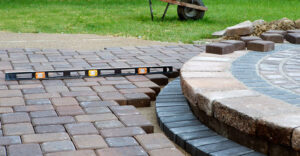Why “Durability” Matters Especially in Massachusetts
In Massachusetts — Boston metro, Worcester County, the Berkshires, Cape Cod — your retaining wall faces:
- Freeze-thaw cycles: water enters small cracks, freezes, expands, and stresses materials
- Heavy rains, snowmelt, and fluctuating groundwater
- Acid rain / pollution, road salt exposure (especially near driveways or roads)
- Variable soils (clay, glacial till, ledge, sandy soil near coasts)
- Local permitting constraints (many towns require engineering or permits above certain height)
A visually beautiful wall is worthless if it fails after a few winters. Choosing a material suited to New England’s climate—and combining it with sound structural and drainage design—is what yields a retaining wall that lasts decades.
Top Durable Materials for Retaining Walls (with Local Context)
Here’s a comparison of the most durable (and commonly used) materials in Massachusetts, with pros, cons, and situational fit.
| Material | Durability Estimate* | Pros in MA / New England | Trade-offs / Challenges |
|---|---|---|---|
| Interlocking segmental concrete block (SRW systems) | 30–100+ years (with good maintenance) | Engineered system, freeze-thaw rated, relatively faster install, color/textures available (some mimic stone). | Blocks need quality manufacture; joints and drainage must be correct; can look “engineered” if not well designed |
| Natural stone / fieldstone / granite | 50–100+ years (often truly “heirloom”) | Timeless local look, excellent freeze-thaw resilience, blends with New England aesthetics. | Labor-intensive, irregular shapes require skilled mason, higher cost |
| Poured reinforced concrete (often veneered or faced with stone/brick) | 50+ years (if properly reinforced and drained) | Perfect for tall walls, retaining heavy loads, tight footings | Requires formwork, skilled concrete work, potential cracking if joints not managed |
| CMU (concrete masonry unit) core + stone/brick veneer | 40–80+ years (if waterproofed) | More affordable structural core, good visual flexibility | Waterproofing and drainage critical; veneer must be well bonded |
| Gabion walls (wire cages filled with stone) | 40–80+ years (wire quality matters) | Permeable, excellent drainage, rugged aesthetic, good for steep slopes | Wire mesh can corrode over time; basket design must be robust |
| Timber / pressure-treated wood / railroad ties | 10–30 years (shorter in harsh conditions) | Lower cost, rustic look, easier for low walls under ~3 ft | Vulnerable to rot, insects, shifting; generally considered “temporary” in New England |
* Durability estimates assume correct installation (drainage, base, backfill) and maintenance.
Which Material Often “Wins” in Massachusetts?
For many home projects in Massachusetts, the winner is segmental concrete block systems. These systems combine engineered performance, better cost vs. full masonry or stone, and aesthetic flexibility. Many local suppliers (e.g. Landscape Depot in Framingham / Shrewsbury) carry these block wall systems.
Natural stone is chosen when aesthetics or long-term value justify the investment — especially in neighborhoods or historic settings. And poured concrete or reinforced core systems are selected when height, loads, or slopes demand structural rigidity beyond what block gravity systems can offer.
However — whatever the material, proper drainage, foundation, and design detail often make or break longevity.
Benefits for the Homeowner in Massachusetts
When you choose a durable retaining wall material suited to Massachusetts, you gain:
- Long-term cost savings — fewer repairs or rebuilds
- Increased property value & curb appeal
- Better erosion control, water management, and slope stability
- Less maintenance (once the system is built well)
- Design flexibility — terraces, seating, planters, steps
- Peace of mind in harsh winters
In places like Boston suburbs, Cape Cod, or the Merrimack Valley, investing in a durable retaining wall can help your landscape hold up under coastal storms, freeze-thaw cycles, and heavy snow loads.
Practical Tips: What Really Makes a Retaining Wall Last
Here are on-the-ground details that distinguish a long-lived wall from one that fails early:
1. Base & Foundation
- Excavate to undisturbed (native) soil; avoid building on fill if possible.
- Use a compacted crushed-stone base (¾- to 1½-inch stone) of sufficient thickness (often 6–12 in, depending on height).
- Use geotextile fabric below base to prevent fines migration.
2. Drainage & Backfill
- Use free-draining aggregate backfill (crushed stone) immediately behind the wall to prevent hydrostatic pressure.
- Install perforated drain pipe (weeping tile) at the base, sloping to a safe discharge.
- Use filter fabric to separate soil from stone.
- Add weep holes or drainage holes if needed (especially for stone walls).
- Avoid trapping water behind the wall — water pressure is one of the most common causes of wall failure.
3. Reinforcement (when needed)
- For walls over ~3 to 4 feet (or with surcharge loads like driveways), reinforcement (e.g. geogrid) is often necessary.
- Geogrid extends into the retained soil, locking it with the wall facing to resist tension. Wikipedia+1
- Mechanical stabilization (Mechanically Stabilized Earth or MSE) techniques may apply for very tall walls. Wikipedia
4. Control Joints & Expansion Gaps
- In concrete or veneer finishes, provide expansion joints to allow for movement and reduce cracking.
- Proper bedding and joint alignment in block systems reduce stress.
5. Protecting from Surface Water
- Grade the top surface away from the wall to shed runoff.
- Use gutters, downspouts, and surface drainage to divert water away.
- Avoid concentration of flow onto the wall edge.
6. Material Quality & Manufacturer Specs
- Use blocks rated for freeze-thaw cycles (often marketed as “F-freeze zone” or similar).
- Use stainless steel or polymer pins, clips, or connectors in block systems (avoid plain steel in wet environments).
- For gabion baskets, use galvanized + PVC coated mesh to extend life.
7. Skilled Installation & Inspection
- Even the best materials fail with poor workmanship.
- Use a contractor experienced in Massachusetts soils, frost depths, and permits.
- Inspect each course for levelness and setbacks as you build.
Common Mistakes (and How to Avoid Them)
| Mistake | Why It Fails | How to Avoid |
|---|---|---|
| Overlooking drainage | Water pressure behind wall leads to bowing, cracking, collapse | Always install stone backfill, drain pipe, weep holes |
| Shallow base or poor compaction | Underlying soil shifts under freeze-thaw | Go deep enough, compact properly in lifts |
| Using regular soil as backfill | Finer soils retain water and cause pressure | Use crushed stone or free-draining fill |
| Skipping reinforcement on tall walls | Wall may collapse or bow under load | Follow engineering standards / geogrid specs |
| Choosing wrong materials for climate | Some materials degrade faster under freeze-thaw | Use materials rated for New England climate |
| Ignoring expansion joints | Cracks form due to thermal or moisture movement | Plan expansion/separation joints especially in concrete |
| Poor connection to structures | Adjacent patios, sidewalks shift walls | Tie walls into structures properly (or isolate them) |
| No permit or ignored codes | Municipality orders removal or fines | Check local MA town code; walls over 3–4 ft often need permitting |
FAQ — Common Questions from Massachusetts Homeowners
Q1: How high can a retaining wall be before I need an engineer or permit?
A: It depends on your town, but many Massachusetts municipalities require a permit (or engineered design) for walls over 3–4 feet tall, especially near property lines. Always check with your local building or zoning office.
Q2: Can I mix materials (e.g. block + stone veneer) to get both strength and beauty?
A: Absolutely — a common approach is a structural core (block or concrete) with a stone or natural veneer face. Just ensure waterproofing and bond between layers are properly detailed.
Q3: Do I need to maintain the wall after installation?
A: Yes, minimally: keep drainage clear, remove plant roots near the wall, avoid stacking snow against it, inspect for bulging or settlement. A good wall with occasional inspections can last many decades.
Q4: Is DIY feasible for retaining walls in Massachusetts?
A: For small walls under ~3 feet, with gentle slope and good soil, DIY with block systems or stone might be viable. For anything higher, steeper, or load-bearing, hire professionals.
Q5: Which is “cheapest” durable option?
A: Segmental concrete block systems often hit the sweet spot between cost and longevity. Timber is cheaper initially but typically needs replacement earlier. Natural stone is more expensive but often offers the best long-term value.
If you’re a Massachusetts homeowner looking for a retaining wall that won’t crumble after a few winters, you deserve a solution that’s engineered for New England’s climate — not a “quick fix.”
At Green Leaves Landscape, we specialize in designing and building durable, beautiful retaining walls using materials suited to Massachusetts soils and weather. Whether you prefer the precision of concrete block systems, the timelessness of stone, or a custom reinforced wall, we can:
- Evaluate your slope, soil, and drainage conditions
- Recommend the best material and system for your site
- Handle permitting, design, and expert installation
- Provide a long-term warranty and maintenance advice
👉 Contact us now to schedule a free consultation (no obligation). Let’s design a retaining wall for your yard that will last decades, not years.
Request your custom quote today.






